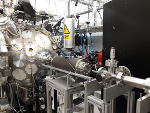ERC proposal Meeting 21st August 2018
Meeting details
14:00 Room 532
Phone details:
UK: 08082 380274 Austria: 0800 006612 PIN: 5904750902
Full list of telephone contacts may be found here.
Agenda:
- Introduction: KL
- Updates on development of systems: All
- Effect of space charge: JPo
- Evolution of the design: JPa
- Discussion of next steps: All
- Summary of actions and timescales
- AoB
Notes:
Present: SG, OE, AK, JPa, RT, LM, KL, JPo,
- Introduction: KL
- KL expressed regret that it had not been possible to find a scope that satisfied the ERC Adv Grant constraints. Recognising the hard work that had gone into the development of the design so far, this was a disappointment. However, it seemed that there was a concensus that the devision was reasonable.
- Updates on development of systems: All
- LM: Working towards simultion of end-station to estimated dose to cells. Cell layer is between 14-30 microns thick. BDSim is not yet interfaced to most accurate low-energy simulation of particle-tissue interactions. Will use the presently-interfaced codes for now. Vacuum window thickness will be provided by JPo: Assume 1cm2 apperture, so window thickness should be a few 10s of microns of some nitride material.
- Effect of space charge: JPo
- Simulation of beam transport from interaction region of laser to 3-4 m from source. Runs were made with 0 space charge and then 5*109, 5*1010 and 5*1010 particles per shot. 100 fs duration, width of the angular distribution as in the file from OE. Assumed flat top distribution.
- Co-propagating charges, so, no space-charge effect at source. Now think that as soon asbeam is larger than 1mm, there is no significant space-charge effect. Blow up of beam at source so fast that space charge looks like it is not an issue d/s of the target.
- Compactifying the lattice: JPa
- See slides.
- AoB:
- JPa: has made an initial study of the next acceleration stage. A spiral FFA ... injection at 8.6, acceleration to 75 MeV (protons). Requires 10 magnets; 3.1M radius. Resonator requires swing between 1MHz and 10MHz. A double spiral scheme has been adopted to accomodate ISIS u/g design. ISIS will consider ferite, rather than MA, cavity. Need to make case with them in RF meeting in beginning of September 2018.
- We agreed we need to consider ion acceleration and agree to focus on: proton, He, Li, carbon, and oxygen
Last modified
7 years ago
Last modified on Aug 28, 2018, 11:53:43 AM
Attachments (1)
- DesignEvolution21082018.pdf (737.5 KB ) - added by 7 years ago.
Download all attachments as: .zip
Note:
See TracWiki
for help on using the wiki.
